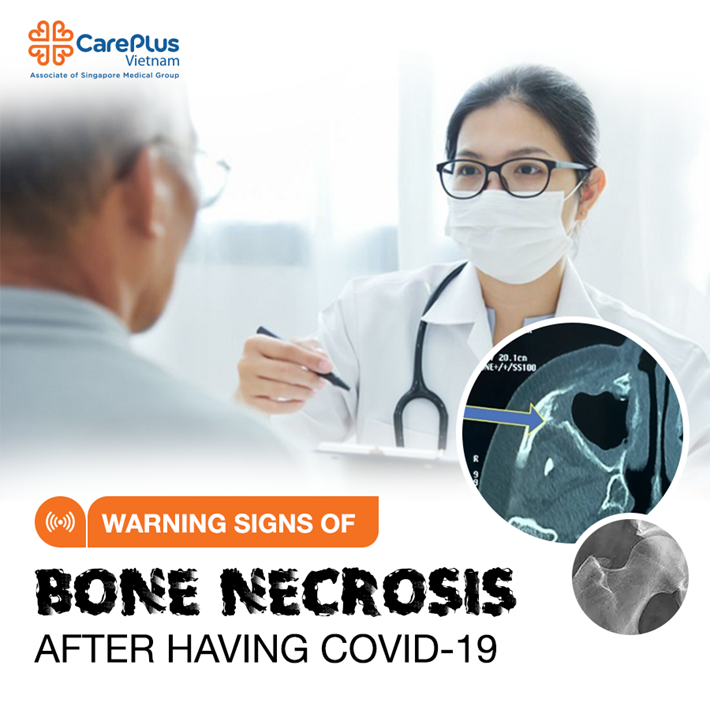Warning signs of bone necrosis after having Covid-19
Recently, several hospitals in Ho Chi Minh City, such as Central Odonto-Stomatology, Ear Nose Throat, and Cho Ray hospital, received many patients with necrosis of skull and jaw bones, two deaths. In particular, the number of patients with osteonecrosis of the upper jaw of unknown cause increased abnormally. Still, the common point was that they had Covid-19 and no ENT or maxillofacial disease history. According to Associate Professor Tran Minh Truong, former Deputy Director of Cho Ray Hospital, and Chairman of Ho Chi Minh City Association of Head and Neck Surgery, based on the patient's clinical manifestations and searching for documents around the world, doctors determined patients with osteomyelitis of the maxillofacial bone, osteomyelitis of the skull base.

8/4/2022 9:42:48 AM
Common symptoms
The patients suffered from pain in the face, teeth, and palate during the Covid-19 infection period, then continued to develop slowly and steadily, without decreasing. Common clinical manifestations are eyelid swelling, swelling of the craniofacial region, necrosis of the jaw, teeth, and roof of the mouth, causing difficulty chewing.
Severe necrosis of the nasal cavity spreads to the base of the skull. The disease has symptoms similar to sinusitis, so it is easy to misdiagnose.
Osteomyelitis of the skull base is rarer and potentially life-threatening. According to RSNA Journals, this is an infection of the temporal, scapula, or occipital bones. The disease is difficult to diagnose because the symptoms are atypical, the clinical course is prolonged, and the X-ray images are easily confused with other conditions.
Patients often have nonspecific symptoms such as headache and facial pain. Most of the time, otitis externa begins with severe pain and purulent ear discharge, leading to hearing loss in some extreme cases. In other cases, people develop sinusitis, which leads to a stuffy nose, runny nose, headache, and fever.
How dangerous is that?
According to Dr. Tuan, if not removed or surgically removed, the necrotic part of the bone will become the focal point of bacteria, leading to septic shock and life-threatening blood infections.
If the disease is detected early, timely treatment can prevent the progression of bone necrosis, but if the necrosis spreads to the skull floor, the level of danger increases.
In patients with skull necrosis, if the infection is transmitted to the brain, it will cause meningitis, and brain abscess, leading to death.
The causes of the illness
Dr. Le Quoc Hung, Head of the Department of Tropical Diseases, Cho Ray Hospital, said that the cause of bone destruction is often due to occlusion of blood vessels, decreased blood supply leading to necrosis, or it may be due to external factors such as microorganisms.
To date, experts have not been able to confirm whether this disease is related to Covid-19. Doctors hypothesized that the body of a person with Covid has a long-term immune disorder, plus that pre-existing medical conditions can lead to more fungal growth in the body, causing inflammation.
Typically, the surrounding environment has many types of microorganisms. When the body is immunocompromised due to disease, it will be easily attacked by bacteria and fungi.
According to Dr. Tuan, the literature gives 4 risk factors for maxillary osteonecrosis. Firstly, nCoV attaches to the ACE2 receptor (which is abundant in the lining of the nose and mouth), causing vascular complications, potentially blocking blood vessels supplying bones, and having Covid-19 also causes increased blood clotting and decreased blood supply.
In addition, using corticosteroids (anti-inflammatory) in the treatment regimen for Covid-19 can also worsen bone nourishment. Another risk factor is the patient's opportunistic bacterial or fungal infection.
Finally, patients with underlying diseases, especially diabetes, will be prone to bone necrosis because the disease reduces blood vessel nutrition, reduces resistance, and affects white blood cell function, so it is easy to superinfect.
Treatment and recommendations
The principle of treatment of necrotic bone is to surgically remove this bone, then attack with antibiotics and antifungal agents for at least 3 weeks, which can last up to 6 months, and at the same time monitor the risk of recurrence. The doctor will consider bone reconstruction and restoration when the patient's condition is stable.
If a patient has symptoms such as headache, pain in the molars, or swelling in the face, after contracting Covid, they need to see a doctor. People with underlying diseases need to be treated to control and avoid severe progression, quickly leading to bacterial and fungal attacks.
The article is referenced from the source: VnExpress